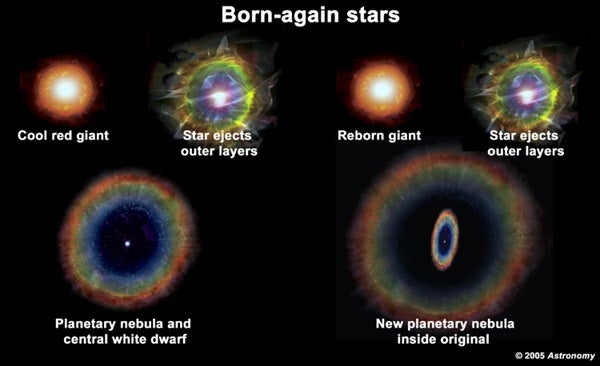On February 20, 1996, Japanese amateur astronomer Yukio Sakurai was hunting comets when he noticed a new starlike object in the constellation Sagittarius. At first, astronomers thought it was an ordinary nova, but the star didn’t fade out with time and its spectrum didn’t fit. In short order, astronomers realized “Sakurai’s Object” was something truly special — a “born-again” red giant.
Within a year of its discovery, the star’s surface temperature dropped 2,000 kelvins. Its hydrogen content fell and the amount of heavy elements, like lithium, rose. Sakurai’s Object ejected its outer layers, which are now so thick with condensed dust particles the star is all but invisible at optical wavelengths.
“We expected the star to remain in this phase until the helium burning turned off,” Albert Zijlstra, an astronomer at England’s University of Manchester, told Astronomy. “Instead, our radio detection shows that the star is already on the way back to the white dwarf stage, surrounded by a new planetary nebula.”
Most of stellar evolution doesn’t occur on a human time scale, but as stars like the Sun evolve from red giant to white dwarf, they undergo a series of thermal pulses. Hydrogen fusing in a shell above the star’s core produces helium, which accumulates in a layer on the star’s carbon core. When the temperature rises high enough in the helium layer, it undergoes a flash of nuclear fusion, expanding the star some 5,000 times and extinguishing the outer hydrogen shell.
A star’s thermal pulses may occur just 10,000 years apart. They help eject the star’s outermost layers, which form the glowing, expanding shell of a planetary nebula. The star itself finally settles down and becomes an Earth-size white dwarf.
Some stars erupt in one final thermal pulse before consigning themselves to white-dwarf oblivion. Because these stars start off as white dwarfs and become red giants — the reverse of normal stellar evolution — astronomers sometimes call them “born-again” stars. All stars between 0.8 and 8 solar masses make planetary nebulae, and perhaps as many as 25 percent erupt in a final thermal pulse after they’ve begun their journey down what astronomers call the “white-dwarf cooling track.” Sakurai’s Object provides a once-in-a-lifetime glimpse of this rapid phase of stellar evolution.
The trouble is, Sakurai’s Object has changed too fast. There’s no sign of the star in images of the region taken in July 1991, but it was found in images taken February 1995. Somewhere in that period, the star erupted — but it became a full-fledged red giant by 1997. “This was the first sign of trouble,” explained Zijlstra, “because models predicted it should have taken 100 years to do this.” The star’s current return to white dwarf status is likewise faster than expected.
The team suggests the initial outburst of Sakurai’s Object was not the star’s helium flash itself, but the ignition of hydrogen fuel much closer to the surface preceding the true flash. “The hydrogen burns rapidly — there is very little of it to begin with — and causes a similar evolution as the helium flash, but much more rapid,” Zijlstra said in an e-mail interview.
The astronomers believe the final helium flash already has started deep within the star. When it reaches the surface, which the team predicts will occur around the year 2200, Sakurai’s Object will be born-again once more. “At that time, the star will again become a red giant, but now evolving at a more leisurely speed,” noted Zijlstra.
In the meantime, the star’s rising temperature will dissolve its dusty shroud, giving astronomers better access. “The real-time evolution of Sakurai’s Object is likely to continue to unfold in the coming decades, to the delight of astronomers,” wrote Martin Asplund of Australian National University in a commentary accompanying the team’s report.
Finally, the team notes that the new nebula around Sakurai’s Object consists of a large fraction of carbon. “If this is typical, we estimate that up to 5 percent of the carbon in the universe could come from such a source,” said Zijlstra.










